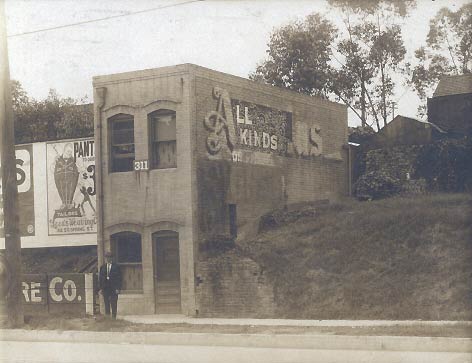
A Visit to Old Los
Angeles
15. Figueroa
Street.
by
Brent C. Dickerson
Copyright © Brent C. Dickerson
Index to Episodes (click here)
A Visit to Figueroa Street, south to Pico
Street; and West of Figueroa.
• We are over the crest of Bunker Hill; the houses no longer look down on the bustling downtown. Figueroa Street has its share of fine homes as well as more modest middle-class domiciles mixed with middle-class hotels and commercial buildings. This slender building, at 311 S. Figueroa Street, had been in 1907 the home of the Angelus Sign Company. Clever use of the sign company's wall sign by a subsequent tenant made the building a refuge for "All Kinds."

• A tidy domicile at the southwest corner of Figueroa Street and Fourth Street.

• Many of the houses are spacious and lushly planted.
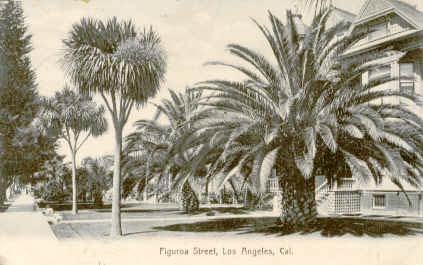
• Californians, and Angelenos in particular, have reveled since the beginning in the flowers they could grow around their homes all year.
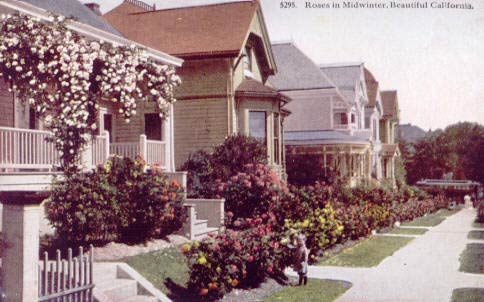
• Aunt Sigrid's friend—Chester's mother—lived on Figueroa, and was especially proud of her Hydrangea bush, as were Chester's brother and sister Maximilian and Dorothea, who pose for us. "I should like very much to live in a spot like this," said Anna, quietly. Minnie responded, "I should prefer an apartment downtown, I do believe."
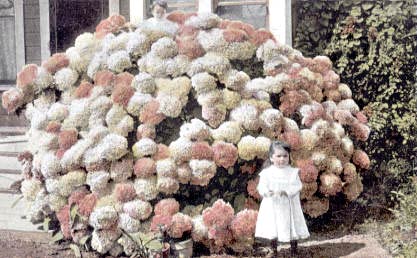
• Dorothea shows us her mother's roses as well.
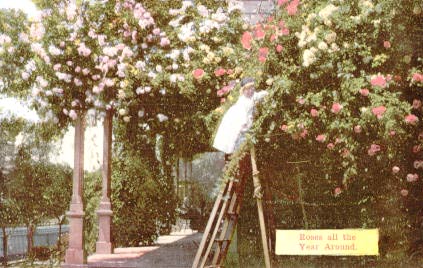
• The Mitchells, across the street, had seen us admiring the flowers and obliged young Frederick Johan to take a picture of them and their flowers as well. Mother conversed with them a while, bade them good day, then came back across the street and whispered to Papa, "Social climbers!—though the child is sweet."
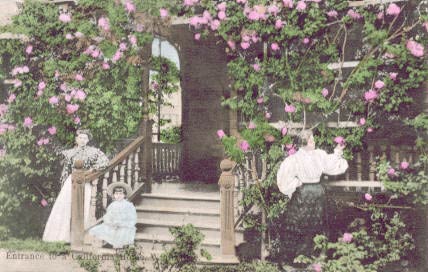
• Later, Charley found a postcard of a house a few doors down from Sigrid's, wrote "Just for two, dear," on it, and sent it to his college sweetheart Amelia . . . and another with the same message to his hometown sweetheart Janella. A few days later, I saw he had several more copies in his baggage. [We use this image generically to show an Angeleno home; the site of this particular house was actually in the low 600s on the east side of S. Spring St. It belonged to a Mrs. Barclay, and was razed ca. the 1890s to make way for office buildings.]
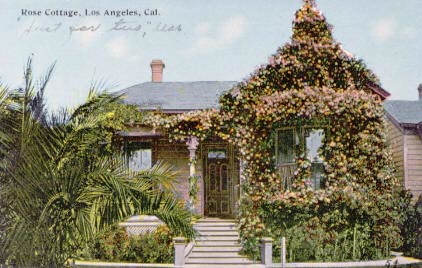
• And here, dear, should you want to stop looking at things along the street and look at the street itself—as who wouldn't?—is a view looking north on Figueroa Street from the corner of Sixth Street. That hulking silhouette behind the palm trees at left is the Bellevue Terrace Hotel, of which more in a moment...
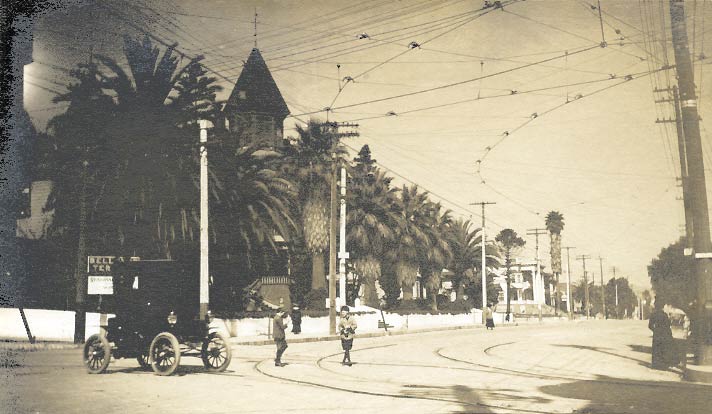
• We find the Bellevue Terrace Hotel at the northwest corner of Figueroa Street and Sixth Street. Summer rates were: "Board and room for one, $30.00 per month and up; for two with same room, $55.00 per month and up. Pool room; dancing and card parties weekly."

• Visitors from the East felt transported to an exotic land, sitting in the shade of a Banana tree in the garden of the Bellevue Terrace. Figueroa Street itself can be glimpsed through the arch of foliage at the right.

• It was not so many years until the Bellevue Terrace was replaced by the Jonathan Club Building. Previously, the Jonathan Club had had quarters—and a roof garden—at the Pacific Electric Building back on Main Street.
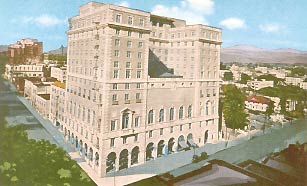
 | • The Gates Hotel, at the southeast corner of Figueroa and Sixth Sts. |
• The baby was fussing, so Mother and Papa stepped into the rather dark lobby and sat down to give him some calm moments out of the sun. A bellhop sprang out of one of the potted palms and cried, "Guests only, ma'am!". Young Frederick Johan strode over to the unattended piano at the other end of the room, and called out, "Is this a real piano?" as he sat down at the keyboard. "Leave that alone!", said the bellhop, running after him. Now it was Anna's turn. "Excuse me," said she to the bellhop from a far corner, "Does the Drawing-Room Poet Peabody Snitt appear here this week?" "No!" "No?," asked Minnie, from near the piano, "Could you show me the entertainment schedule for this week? Surely you have it posted on the wall some place here?" "This way, miss; over near the front counter." Minnie and Anna feigned interest in the listing until Papa signaled to us "folk" that Mother and the baby were ready to go.
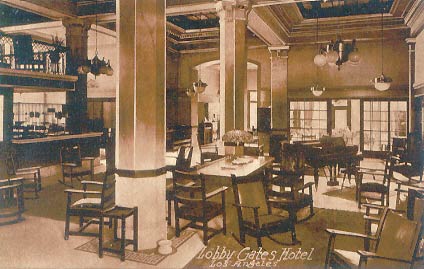
• Charley had slipped away from the rest of us and asked the clerk at the front desk for a rate sheet. "Why?", was my whispered question. He shrugged and said, "Well, you never know..." Minnie caught the tail end of this exchange and demanded—a little shrilly, I thought—"You never know what, Charley?" "I was saying to Ulf, 'You never know what silly thing Minnie is going to say next!', wasn't I, Ulf?". I cleared my throat and said, "My, I wonder how many rocking chairs are in this lobby...?"
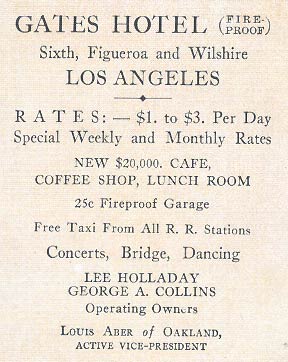
• We were ready for a bite to eat at the hotel's cafe; but Mother remonstrated, "Pshaw! Sigrid's is only a few blocks away. And better food, too, I don't doubt," which latter comment bought her a sharp look from the maître d', as well as a languishing look from Minnie.
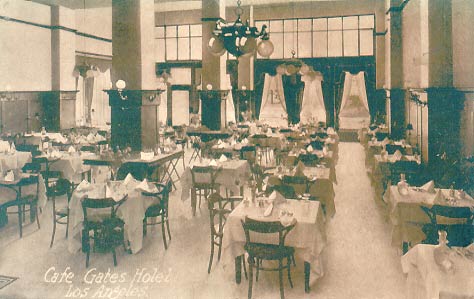
• An idea of lodging conditions at the Gates.
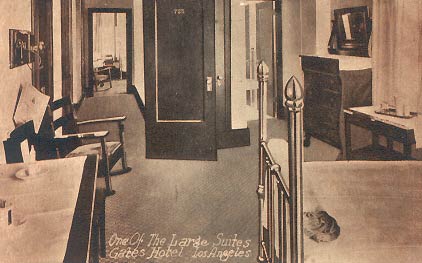
• Young Frederick Johan of course misses no chance to climb to the top of buildings; and so it was that he and I climbed the Gates Hotel stairs all the way up. For all the quietude and residential appearance of the street, it can't be forgotten that the bustling downtown is only a few blocks east. Here is a view east down Sixth Street towards downtown from the roof of the Gates Hotel at Figueroa and Sixth. The white building just to the right of the arrow is the Pacific Mutual Building at Sixth and Olive.
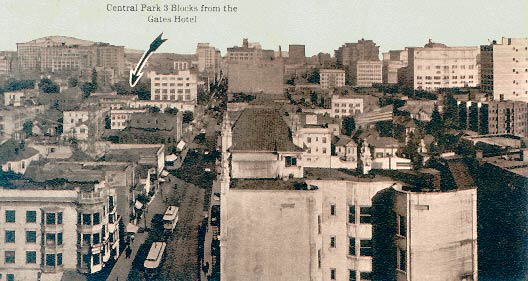
• From the same rooftop, we turn from east to southeast and take in the view.
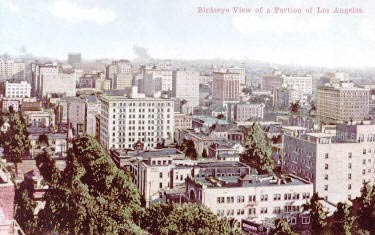
• We come down from the roof the Gates Hotel, and see the Hotel Lee at 822 West Sixth Street, immediately east of the Gates Hotel at the corner with Figueroa. A sliver of it can be seen in our exterior view of the Gates Hotel above.
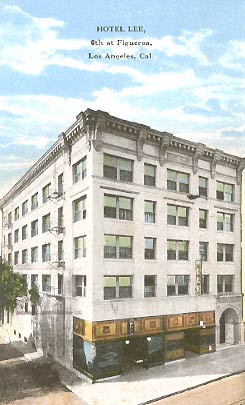
• The firehouse for Engine Co. No. 28 was at 644 S. Figueroa Street. Anna and young Frederick Johan discussed the pros and cons of this concerning the guests at the Gates Hotel. "I'd sleep soundly knowing that firemen were next door!", declared young FJ. "Oh, but think of the noise!" was Anna's concern. Minnie put her hand on FJ's head. "This young man," said she, "would sleep soundly if the Battle of Bull Run were taking place next door."
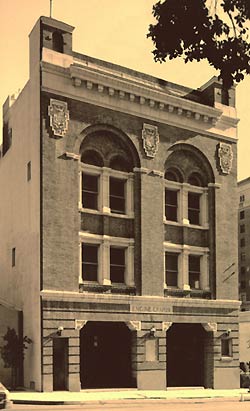
• The next cross-street on Figueroa between Sixth and Seventh Streets is Orange Street [now Wilshire]. At 945 Orange Street, just around the corner from Figueroa, we find the Rex Arms Apartments.
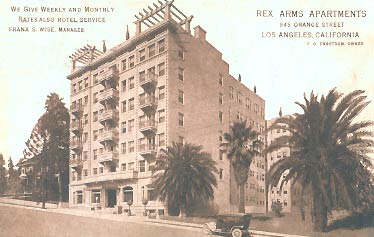
• The E.A. Forrester home had stood at 865 W. Seventh Street, just off Figueroa, until about 1891.
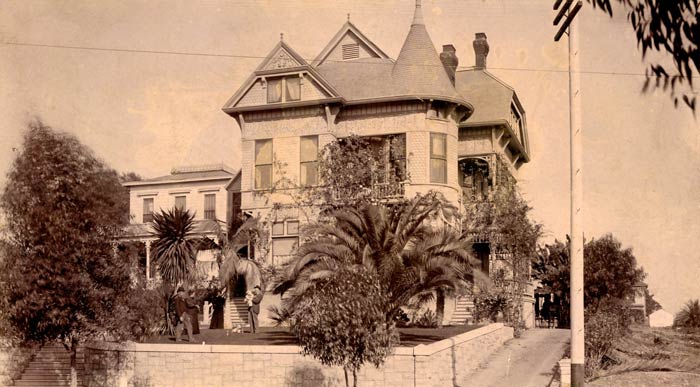
• The Forrester family is easy to miss in the panorama of the grand home.
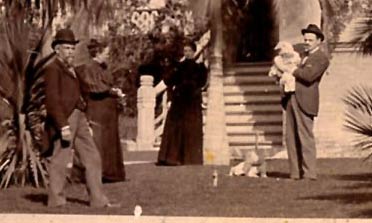
• Spanish associations were always a plus in catching the attention of the tourist trade. The Hotel Cordova stood at 808 S. Figueroa.
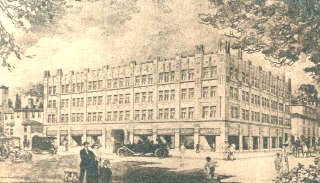
• The Cordova lobby was modern and cheerful, even having a water-cooler at hand for use of the guests. I noted with dismay that the mania for rocking chairs had not left this lobby untouched.
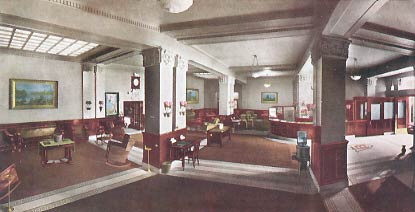
• As we passed the nearby Fraternal Brotherhood Building, on the west side of the street, Charley remarked, "Well, Fraternal Brotherhood is all very well; but, as for me, I should prefer . . . " A severe look from Mother made Charley's sentence end in a series of coughs. Minnie smirked. "But what would you prefer, Charley?" she asked. "Universal peace and prosperity—right, Charley?" prompted Papa. "Indeed," said Charley.
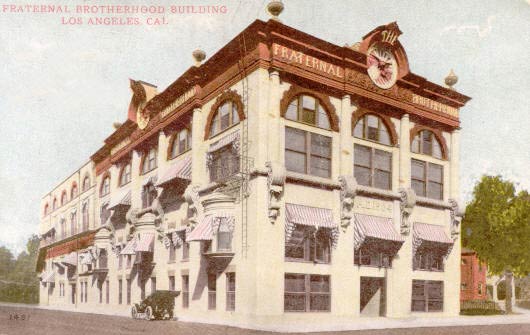
• City buildings continue to creep out into the suburbs; here we find the Ivins Apartments at 10th and Figueroa.

• Close by was the Hollman Business School. "Such a career," said Charley, "would make me feel like a half-man." Papa thought for a moment and said, "Half before the whole, Charley." —Upon which, Mother gave him that rarest of the rare, a public kiss on the cheek. Young Frederick Johan looked at me and said, "Oh, the scandal!"
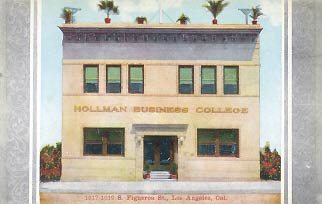
• Immigrants try to anchor their old culture in their new land. The many German immigrants in Los Angeles founded the Turnplatz und Gymnasium des Turnverein Germania on Figueroa Street near the corner of Pico Street. Pico Street is what otherwise would be 13th Street.
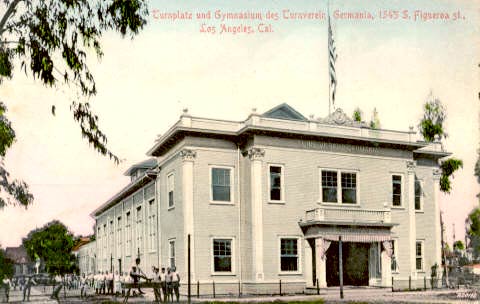
• The last remnant of the civic zanja system—open channels of water for citizens' use—was to be found along Figueroa Street. The system dated back to the earliest days of the pueblo; at one time, the highest-paid civic official was the person in charge of the system, the zanjero.
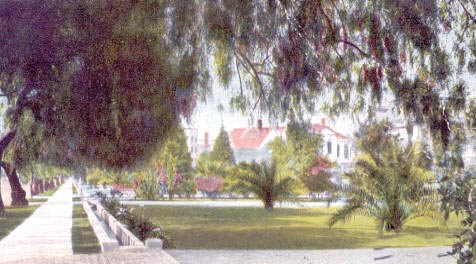
• Papa thought these park-like grounds which the larger homes in this area sat on were very fine to look at; "but wouldn't it be wiser to turn them to account with fruit trees and an acre or two of vegetables?" Anna noted that the finer the house, the larger the yard, the fewer people to be seen.

• Minnie sighed deeply and said, "I should think that a tax on palm trees here would be a considerable source of income." Mother said that she suspected that it would pay off the National Debt.
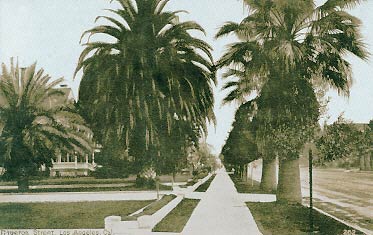
• Yet further along Figueroa, the houses were newer, the grounds unplanted or with young trees. Once again, we were at the growing edge of the city.
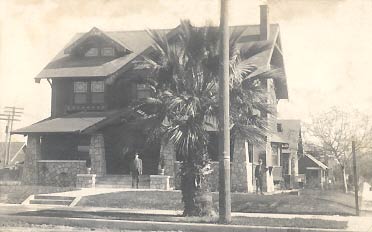
• The next day, Aunt Sigrid sent us first one block west of Figueroa, to Fremont Avenue and past the humble Fremont Arms Hotel . . .
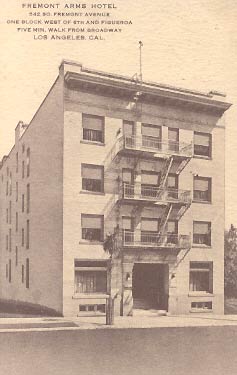
• . . . And then on to Beaudry Avenue, "For a sight I should say was less than common," as she put it. The Standard Bread Company, located at 532 S. Beaudry, was displaying its fleet of delivery trucks.
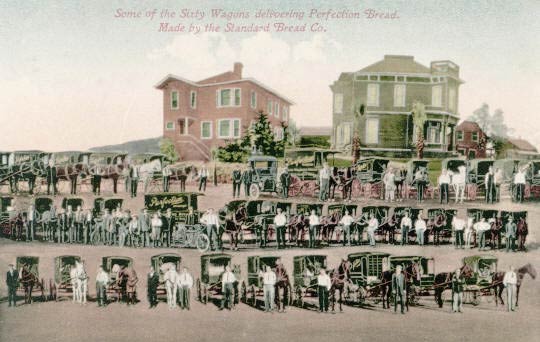
| • The Harbour Apartments were just a block away at 612 St. Paul Avenue. Their handbill says, "Rates not high, only sufficient to insure a good class of patrons." Young FJ thought a moment and asked, "Doesn't that imply that, the more money you have, the 'more good' one is?". At that thought, Mother frowned, and Papa said, "Well, then I guess I'm pretty near Hell, that's what I guess!". |  |
• Across the street, at 641 St. Paul, could be found the M.E. Blasier Apartments. "It has a roof garden," said Anna at dinner that evening. "That," answered Aunt Sigrid, "generally means a dead potted palm next to a dusty lawn chair."
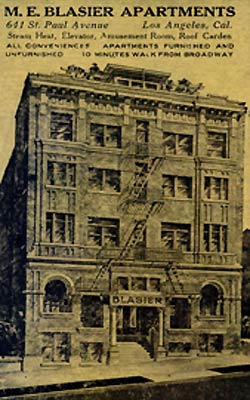
• A few blocks north could be found The Huntley, at 1207 W. Third Street. We had seen its sign when we were at the crest of Bunker Hill before.
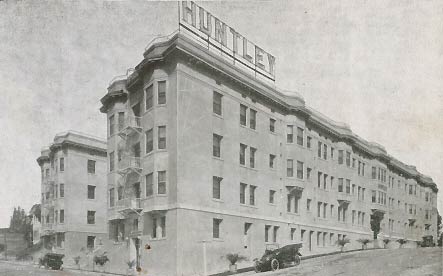
• "Charley," complained Minnie, as we went a few blocks south again, to Columbia Hospital, not far from the Harbour Apartments, "you're taking us in circles! Mother, he's just driving back and forth looking for girls!" "I wouldn't drive to a hospital to look for girls." Young FJ added, "And this isn't circles; the route has been fairly linear, north, and south, and north, and south, and…" "That's enough, young man," said Papa. [Columbia Hospital was at the northeast corner of Orange (i.e., Wilshire) and Witmer streets . The cornerstone was laid in December, 1910; and it was opened to the public in December, 1911. Good Samaritan Hospital is now on the site.]
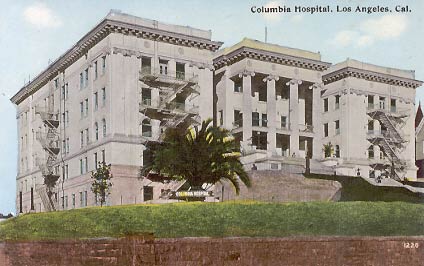
• "Now we are going not North," declared Charley, "and not South, but West." We rolled along in silence for a block or two; then Anna ventured to ask, rather quietly, "Where are you taking us?" "I have no idea." Mother heaved a sigh, and said, "Charley, please take us home. The baby is getting fidgety." "Oh, Mother," said Minnie, "look at his face—he's lost—our bleached bones will be found at some intersection in a month or two!" "I am not lost." "Then where are we?", I asked. "I don't know; but I'm not lost." After a few random turns, presenting us with nothing familiar, Papa had Charley pull up in front of this apartment building—at the corner of Cambria and Union streets, as if we had ever heard of such streets—where he asked directions, dispossessed Charley of the steering wheel, and drove us back to Aunt Sigrid's, shaking his head sadly the whole way.
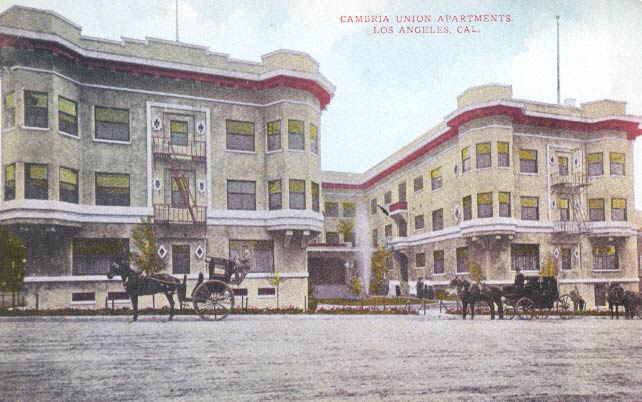
Return to Hope Street and Flower Street; or on to a Fiesta and the closer environs . . .